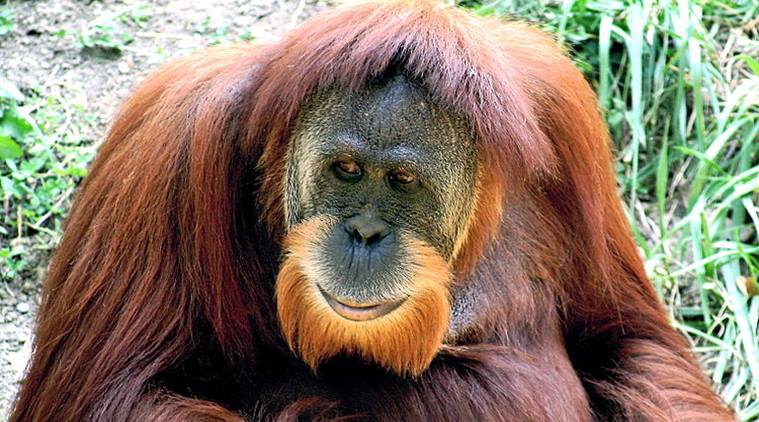Down in Jungleland: Family Ties
On our closest relatives in the natural world. Since, like it or not, we are all related in this natural world, we might as well make the best of it.
 The orangutan is intelligent, solitary, deliberate in its movements and has a great sense of humour. (Source: Wikimedia Commons/Kabir Bakie)
The orangutan is intelligent, solitary, deliberate in its movements and has a great sense of humour. (Source: Wikimedia Commons/Kabir Bakie)
Since, like it or not, we are all related in this natural world, we might as well make the best of it. After all, there are only four kinds of them who we can claim as our closest kin: gorillas, chimpanzees (of two species), orangutans and gibbons. The first three are known as the “great apes”, the gibbons are called the “lesser apes” and we, I suppose (provided no one takes offence), would classify as the “greatest apes”. And since I have been told repeatedly that I should stay more in touch with relatives, I will touch base here with all of them.
Of course, as a child, I was terrified of gorillas. There were so many lurid stories about King Kong and his ilk, and their fearful chest-thumping before charging with fury at people and doing unspeakable things to blondes. Heroic white hunters would stand firm in front of these monsters and take them down with a bullet between the eyes. Sense dawned much later, when stories began doing the rounds about how sagacious and gentle gorillas were in reality. It made perfect sense: any creature with the physique of a silverback didn’t really have to throw its weight around. All it had to do was look in your direction. Sometimes, they did thump and roar but only at one another, or, if you threatened to kidnap their babies, in which case you often had to shoot every adult gorilla in the group first. When wildlife films (often courtesy National Geographic) started being screened on TV, you could actually look into these great animals’ troubled and reproachful eyes. All they wanted was to be left in peace in their verdant rainforests and mountains, so they could eat leaves to their hearts’ content. They had a couple of patrons to thank for causing this change in perception, the late Dr Dian Fossey, who lived amongst them for years and was murdered for standing by their cause, and, Dr George Schaller. Of course, there were several reports of gorillas in zoos taking care of children who had fallen into their enclosures.
Then there are the chimps, and who hasn’t, as a child, gone into peals of laughter watching them throw “tea parties” at the circuses or in zoos? Chimpanzees are supposed to be the closest to us, and, personally, I’m not all that enamoured by them. Sure, the babies are sweet, with their big expressive eyes and laughing faces, but as adults… they have that shrewd look, as if they’re sizing you up. As for their notorious volatility — that’s a bit hard to stomach, too. One second they’re quietly grooming one another, the next, they start swaying and “pant-hooting” and then charge, flinging stones, excreta, and sticks around. Then they’ll be kissing and making up as if nothing happened before the next tantrum erupts. But chimps, too, have a patron saint, in Dr Jane Goodall, though I bet she must often have felt like smacking some of those tantrum-throwing delinquents.
But there’s some salvation here, too, thanks to the second species of chimpanzees — what I call the “hippie chimps” or bonobos. “Make love man — all the time, every time, not war” — that’s their philosophy of life and boy, do they live up to it! That’s how they settle disputes.
While gorillas and chimps hail from the “dark” continent, the gentle-eyed, red-haired orangutan hails from the tropical rainforests of South East Asia, though, now, they are unfortunately confined just to the rainforests of Borneo and Sumatra. This one is my favourite: intelligent, solitary, slow and deliberate in its movements and with shrewd eyes twinkling with good humour. They always look like they’ve just played a dirty trick on you and are chuckling to themselves. Their babies are irresistible — which means they are kidnapped in large numbers for the pet trade — and many end up in shelters where they have to be trained to be wild orangutans again.
As for the gibbons, they are much smaller but they are the acrobat troubadours of the South-East Asian rainforests. We’re lucky to have at least one species in India — the Hoolock — and to hear it sing as it swings nonchalantly through the forest canopy, with those long arms, first thing in the morning, is something you are not likely to forget.
While we now know much more about the lifestyles of our nearest relatives (even if some of the similarities between us are disquieting) and have accorded most of them legal protection, we are still unrelentingly destroying the places they call home — and moving in. Until this stops, that day will not be far off when we don’t have any wild, wacko and wonderful relatives left at all.





- 012 hours ago
- 0211 hours ago
- 0311 hours ago
- 0411 hours ago
- 052 hours ago


























